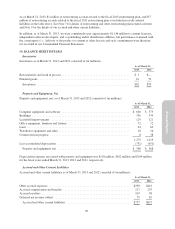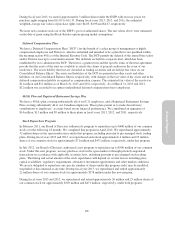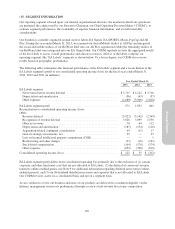Electronic Arts 2013 Annual Report Download - page 180
Download and view the complete annual report
Please find page 180 of the 2013 Electronic Arts annual report below. You can navigate through the pages in the report by either clicking on the pages listed below, or by using the keyword search tool below to find specific information within the annual report.
(14) STOCK-BASED COMPENSATION AND EMPLOYEE BENEFIT PLANS
Valuation Assumptions
We are required to estimate the fair value of share-based payment awards on the date of grant. We recognize
compensation costs for stock-based payment awards to employees based on the grant-date fair value using a
straight-line approach over the service period for which such awards are expected to vest.
We determine the fair value of our share-based payment awards as follows:
•Restricted Stock Units, Restricted Stock, and Performance-Based Restricted Stock Units. The fair value
of restricted stock units, restricted stock, and performance-based restricted stock units (other than
market-based restricted stock units) is determined based on the quoted market price of our common
stock on the date of grant. Performance-based restricted stock units include grants made (1) to certain
members of executive management primarily granted in fiscal year 2009 and (2) in connection with
certain acquisitions.
•Market-Based Restricted Stock Units. Market-based restricted stock units consist of grants of
performance-based restricted stock units to certain members of executive management that vest
contingent upon the achievement of pre-determined market and service conditions (referred to herein
as “market-based restricted stock units”). The fair value of our market-based restricted stock units is
determined using a Monte-Carlo simulation model. Key assumptions for the Monte-Carlo simulation
model are the risk-free interest rate, expected volatility, expected dividends and correlation coefficient.
•Stock Options and Employee Stock Purchase Plan. The fair value of stock options and stock purchase
rights granted pursuant to our equity incentive plans and our 2000 Employee Stock Purchase Plan
(“ESPP”), respectively, is determined using the Black-Scholes valuation model based on the multiple-
award valuation method. Key assumptions of the Black-Scholes valuation model are the risk-free
interest rate, expected volatility, expected term and expected dividends.
The determination of the fair value of market-based restricted stock units, stock options and ESPP is affected by
assumptions regarding subjective and complex variables. Generally, our assumptions are based on historical
information and judgment is required to determine if historical trends may be indicators of future outcomes.
The estimated assumptions used in the Black-Scholes valuation model to value our stock option grants and ESPP
were as follows:
Stock Option Grants ESPP
Year Ended March 31, Year Ended March 31,
2013 2012 2011 2013 2012 2011
Risk-free interest rate ......... 0.4-1.0% 0.4 - 1.8% 0.3 - 2.6% 0.1 - 0.2% 0.1 - 0.2% 0.2 - 0.3%
Expected volatility ............ 40-46% 40-46% 39-45% 35-42% 39-41% 34-38%
Weighted-average volatility .... 43% 43% 42% 38% 41% 36%
Expected term ............... 4.4years 4.4 years 4.2 years 6-12 months 6-12 months 6-12 months
Expected dividends ........... None None None None None None
The estimated assumptions used in the Monte-Carlo simulation model to value our market-based restricted stock
units were as follows:
Year Ended
March 31, 2013
Year Ended
March 31, 2012
Risk-free interest rate ................................................ 0.2-0.4% 0.2 - 0.6%
Expected volatility .................................................. 17-116% 14 - 83%
Weighted-average volatility ........................................... 35% 35%
Expected dividends .................................................. None None
There were no market-based restricted stock units granted during the fiscal year ended March 31, 2011.
96
























